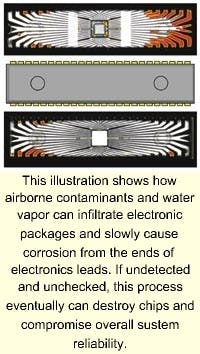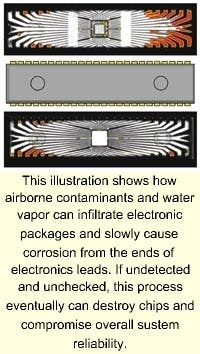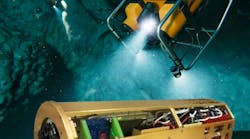By Al Hawes and Tom Adams
Guest Viewpoint
On the deck of a ship, with the sun blazing and the air laden with salt spray and exhaust fumes, weapons operators activate the ship's fire-control computer and a surface-to-air missile. The modern computer, procured under commercial off-the-shelf (COTS) guidelines, contains numerous plastic encapsulated microcircuits (PEMs), rather than the hermetically sealed ceramic-packaged integrated circuits it would have contained a decade ago. Shipboard personnel test the computer periodically, but will it work now when they need it most?
The military's wide use of plastic-packaged electronic components officially began with the so-called "Perry Memo" some six years ago, but the transition to viability is still in its infancy. The major purpose for the change was cost: a ceramic-packaged component can initially cost 10 or more times what the same component will cost as a COTS PEM. The chip inside may be virtually same as it would be in a ceramic package; only the protective package technology differs.
The military can still use hermetically sealed ceramic packages, which protect the die and wire bonds from the environment, if the application justifies the initial cost difference — and if military program managers can find suppliers to provide the hermetically sealed package.
"Environment" in this case refers to humidity and chemical contaminants found in the atmosphere. The established reliability of military-grade devices — no more than 5 percent failures in 90 percent of applications — was known at purchase. The term military-grade parts most often refers to components that meet the requirements of the Qualified Parts List QPL) and Qualified Manufacturing List (QML), which are standards of the U.S. Defense Electronics Supply Center Columbus in Columbus, Ohio — better known as DESC.
Yet COTS PEMs have no such pedigree, nor do they have an effective traceability. The ability to trace the pedigree of an electronic component is also a standard requirement of QPL/QML acquisitions to ensure the location of reported "bad" lots.
Moisture absorption
Plastic packages absorb moisture. In roughly 24 hours, any PEM will become saturated, meaning that it has reached equilibrium with the surrounding atmosphere and will not absorb any more moisture. The water molecules and absorbed contaminants travel throughout the encapsulant.
In most consumer electronics, humidity problems do not influence system reliability or performance as much as they do in military applications. When a two-year-old office printer fails, after all, most owners will simply replace it with a more advanced model. But military and aerospace electronic systems often must perform reliably for at least five to 10 years — sometimes even longer. Usage patterns are different too. Smart weapons, for example, may be used only once, but may have to be stored without failure and without performance degradation for several years before being used.
For the military, there are two problems that systems designers must overcome when they choose COTS PEMs. First, the military has little to no documented history to rely on when specifying PEMs for specific military applications. No one knows how long a specific part will last, or what conditions may be especially harmful to it.
Second, it is impossible to predict what environments a particular electronics system will encounter. Temperature alone can vary from well more than 100 degrees Celsius to far colder than 0 C. More than 130 atmospheric contaminants exist that affect plastic packages. These can vary from evaporated fuel to ozone to various acids. Even seemingly harmless office atmospheres can be corrosive.
In the face of these problems, can designers successfully use COTS PEMs (and other commercial parts) in military applications? The answer is yes, but with some strong — and often expensive — qualifications. Good engineering practices can overcome many of the limitations inherent in these less expensive packages, but designers must well understand the behavior of PEMs in the intended applications.
Atmospheric contaminants
We humans tend to perceive the surrounding atmosphere as either dry or moist, but there is always enough moisture present for absorption into plastics. The water molecules making up this moisture have two important properties — they are excellent solvents, and they normally are excellent catalysts for promoting corrosive chemical reactions.
Contaminants accompanying water molecules are of three main types: reactive gasses such as nitrogen oxide, suspended gases such as sulfuric acid, and suspended hygroscopic ionic particles such as ammonium nitrate. In addition there are several inorganic compounds and metals such as sodium chloride, iron, and aluminum.
Water containing various contaminants first appears on the surface of a plastic package as invisible condensation. At 60 percent relative humidity, a layer of moisture two to four molecules thick forms. Since water is a catalyst, chemical reactions begin even in this extremely thin layer. If the relative humidity reaches 80 percent, the layer is from five to 20 molecules thick, and ions are able to flow on the surface of the layer.
The combination of moisture, acids, and carbon can form a corrosive cell with carbon as the cathode. Surface carbon, in fact, has been established as a corrosive agent in applications such as a residue on cleaned and rinsed automotive sheet metal. Soon this reactive mixture absorbs into the plastic package. Absorption is more rapid if the package is thin — and in commercial and military/aerospace packages the trend is constantly toward thinner, smaller, and lighter packages.
Inside a PEM, moisture and contaminants tend to collect on surfaces. Moisture and contaminants tend to settle in delaminations or voids where the plastic is not in contact with the lead frame, and unwanted chemical reactions will begin. Delaminations and other internal anomalies are often the result of processing errors.
If the moisture and contaminants settle in a delamination along one of the fingers of the lead frame, corrosion can start on the surface of the metal lead going to the chip. The moisture and contaminants can also move by capillary action along a lead toward the chip, where they will eventually encounter the wire bonds from the chip to the lead frame. The bonds of the wire are especially vulnerable to corrosion, which can also travel to the chip itself.
Popcorning and latent defects
Moisture alone, without contaminants, can cause a PEM failure. If a surface-mount plastic package absorbs enough moisture before mounting on a printed circuit board, the heat applied during the re-flow operation can turn the absorbed moisture to steam. Since water increases its volume by 1,728 times when turning to steam, the resulting vapor pressure can result in an audible "popcorn" crack in the package.
Large popcorn cracks — they may cover half the package area — usually destroy the PEM, so there is no threat to long-term reliability. But non-audible popcorning may result in smaller delaminations, voids, or cracks. These small internal package defects — and others resulting from process errors — are actually much bigger threats than latent defects.
Internal delaminations, voids, or cracks that will permit moisture and contaminants to settle on internal metal surfaces are very likely to become sites for corrosion. It is impossible to predict what chemicals will be involved in the corrosion, how far the corrosion will travel internally, or how long the corrosion will need to break an interconnect.
HAST and other tests
One of the most important tests to counter the danger of internal corrosion is the HAST (Highly Accelerated Stress Test), which subjects components to a temperature of 130 C. at 85 percent relative humidity at a pressure of 2 atmospheres, usually following a pre-conditioning program that simulates the expected pre-assembly to assembly conditions. HAST is a rigorous test, especially when testers implement biasing. It forces moisture into the plastic package and accelerates corrosion based on incompatible materials — a metal wire and a metal bond pad, for example. But there is one limitation: HAST uses de-ionized water, so atmospheric contaminants which can also cause corrosion over time in the field or in storage are not present.
Test and measurement experts can use additional environmental tests during a new product assessment, such as acoustic microscopy imaging to inspect the parts for internal delaminations, voids, internal cracks, and poor attachment at interfaces of concern.
Acoustic microscopy is a proven effective nondestructive inspection method for finding defects where moisture can accumulate and where corrosion can occur. Since the method is nondestructive, it permits parts to be subjected to additional testing. Final acoustic imaging provides information for assessment of new product by lot sampling, and can it can also applied as a tool either by sampling or 100 percent inspection of parts to be used in the production of systems hardware. While this information does not provide complete protection against component failure, it helps to minimize corrosion possibilities.
Special testing for unique applications can include a corrosive gas flow test that blows a constant stream of mixed gases (expected in an application and which are known to cause corrosion) onto the component under assessment. To date, the gas flow test has had limited acceptance as a viable test method in PEM assessments.
Temperature concerns
Aside from problems of moisture and corrosion, device operating temperature is a concern when selecting COTS parts. One school of thought suggests that the military can upgrade inexpensive commercial parts by buying small lots of a given part from various manufacturers, test these lots at progressively higher temperatures (recharacterizing), and make final purchase from the manufacturer whose components survived at the highest temperatures.
While it is true that commercial parts sometimes work above their rated operating temperatures, the properties of the same part from the same manufacturer will vary from one production lot to the next and sometimes within the same lot. Also, the manufacturer's cited operating temperature limits may be misleading. What matters is not the ambient operating temperature, but the temperature actually reached by the junctions within the device. A commercial COTS PEM rated at 70 C ambient operating temperature can be used at a higher ambient temperature whenever the PEM junction temperature is kept within design limits.
Recommendations
To use COTS PEMs successfully in military applications, the following methodology may be helpful:
- Determine the specifics of the application, the expected life, and the expected environment including, to the extent possible, exposure to contaminants and extreme temperatures.
- Make a reliability assessment of the PEM for this application. The reliability assessment should include biased HAST, or at a minimum 85/85 (humidity and temperature testing), with acoustic micro imaging to find internal defects after each test. The application may require other tests such as thermal shock, temperature cycling, dew point, impact, salt spray, and corrosive gas flows.
- As part of the future acquisition assessment, look into the financial stability of the component manufacturer. When manufacturers encounter financial setbacks, quality usually suffers. There is an old saying, "When the ink goes red, QC goes dead!"
- Consider special steps to enhance the long-term reliability of the PEM. One method, likely to become much more widespread, is to house the component or subassembly in a moisture-sealed enclosure, perhaps with a desiccant.
Sonobuoy designers, for example, use O-ring seals on the storage container and the sonobuoy itself, along with a desiccant. Other reliability/performance enhancing modifications are possible. One calibration circuit, for example, was required to perform within tighter temperature drift limits than the device manufacturer had specified. Since accuracy depended on temperature stability, the circuit was housed in an oven accurately maintained above expected room ambient, but below maximum junction temperature. In this application, excellent performance and reliability have been achieved for 25 years of worldwide field operation.
Al Hawes is an engineer with the Microelectronics Engineering Laboratory of the Naval Surface Warfare Center in Crane Ind. Tom Adams is a consultant in Lawrenceville N.J., and a contributing reporter to Military & Aerospace Electronics magazine.




